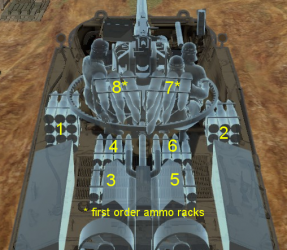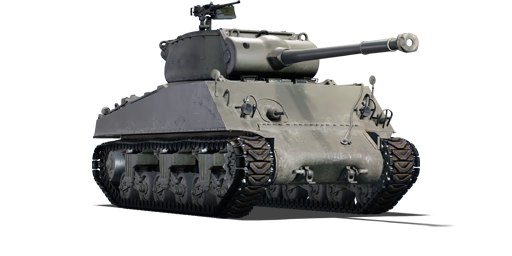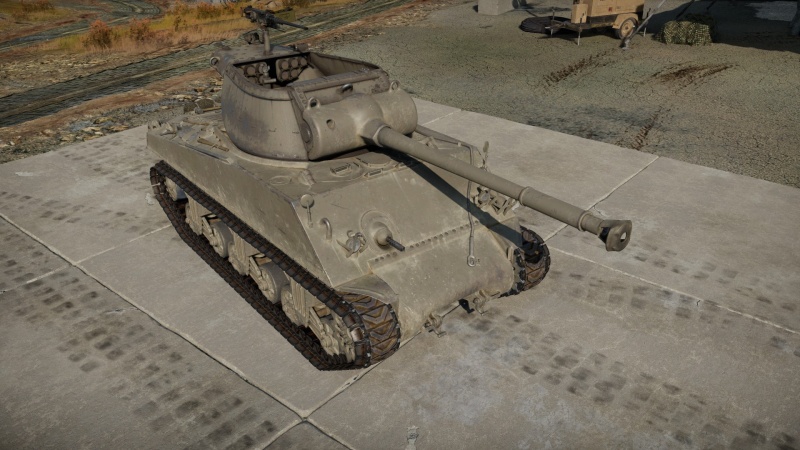Difference between revisions of "M36B1"
(→History) (Tag: Visual edit) |
(→History) (Tag: Visual edit) |
||
| Line 198: | Line 198: | ||
== History == | == History == | ||
| − | + | In September of 1942 the US Army had begun to equip its specialized departments to bolster their fight against German tanks, with the new self-propelled M10 armed with a powerful 76mm M7 cannon, although it was evident that the evolution of armor from the opposing tanks would soon force the US Army o to equip itself with a new vehicle armed with a much more powerful cannon. The ideal candidate for this new role was the M1 90mm anti-aircraft gun, so much so that in April 1942 the first prototype of the new vehicle was built based on a turret mounted directly on the hull of an M4 tank and armed with this gun. To evaluate the installation on an armored vehicle, two examples of the M1 cannon were modified, subsequently this new weapon was standardized with the provisional abbreviation T7 to which became the M3 model. One of these two guns would be mounted on the prototype of the self-propelled M10 in order to evaluate the possibility of converting part of the production of this vehicle, and in fact no particular problems arose that suggested the opposite. However, it was decided to evaluate the possibility of creating a new turret because the M10 turret presented many balancing problems that made it difficult to continue using it. The task of making the new turret was entrusted to Chevrolet. On December 9, 1942 the vehicle was standardized as "90 mm Gun Motor Carriage T71" when based on the hull of the self-propelled M10A1 (equipped with the Ford GAA petrol engine) and "90 mm Gun Motor Carriage T71E1" when based on the hull of the self-propelled M10 (equipped with the General Motors 6046 diesel engine made by combining two GM 6-71 commercial engines). | |
| + | |||
| + | In 1944 of these models only the first was standardized which ended up becoming the <nowiki>''</nowiki>90mm Gun Motor Carriage M36<nowiki>''</nowiki>, due to the fact that the US Army was willing to equip itself only with petrol-powered tanks. Finally in 1944, the M36B1 version also first appeared, mounting the turret of the M36 on a normal hull of the M4A3 tank. The production of the M36 was continued up until December of 1944 when it ceased, with an estimated total of 1,400 units being made. In May 1945, due to the continuous demand of troops in Europe, the assembly line was reopened. Unfortunately due to the lack of M10A1 hulls, ones originating from M10 had to be used instead, therefore the M36B2 version was born which would be built in 672 units. In Italian service most of the M36B1's would be given by America under the <nowiki>''</nowiki>M.A.P<nowiki>''</nowiki> (Military assistance Program), since Italy post war was scavenging for any military vehicles they could get their hands from. In some instances they managed to bring back several versions of Semoventes to reuse. Due to the M36B1 being used in limited numbers, there's not much documentation on their use, but they'd likely be on the frontlines if the Soviet Union ever decided to actually invade. | ||
== Media == | == Media == | ||
Revision as of 15:27, 17 April 2021
| This page is about the American tank destroyer M36B1. For other uses, see M36 Jackson (Family). |
Contents
Description
The Cannone da 90/50 Semovente M36B1 (shortened to M36B1) is a rank Italian tank destroyer with a battle rating of (AB), (RB), and (SB). It was introduced in Update 1.85 "Supersonic".
General info
Survivability and armour
Armour type:
- Rolled homogeneous armour (hull)
- Cast homogeneous armour (turret, gun mantlet, transmission housing)
| Armour | Front (Slope angle) | Sides | Rear | Roof |
|---|---|---|---|---|
| Hull | 63.5 mm (47°) Front glacis 63.5 mm (47°) + 25.4 (spherical) MG port 63.5-107.9 mm (13-77°) Transmission housing |
38.1 mm | 38.1 mm (22°) Upper plate 38.1 mm (13°) Lower plate 38.1 mm (44°) Lower glacis |
19.5 mm 5 mm Radiator vents |
| Turret | 31.75 mm (2-53°) Turret front 76.2 mm (cylindrical) Gun mantlet |
31.75 mm (18-27°) 25.4 (cylindrical) Bustle |
25.4 mm (2-23°) Bustle 31.75 mm (spherical) Turret underside |
N/A 25.4 mm Bustle |
Notes:
- Suspension wheels are 15 mm thick while bogies are 10 mm thick and tracks are 20 mm thick.
- The belly of the tank destroyer is 25.4 mm thick.
At its battle rating, the M36B1's chassis is quite weak, being unable to survive most shots by other tanks. As with all M4A3: the sides are even more vulnerable, their high profile makes them a large target as well. The lightly armoured turret is often vulnerable to ammo rack detonations, with its first stage ammo being stored in the rear of the turret. The M36B1 is also an open top, exposing it to aircraft that can easily rip and tear apart the tank.
Mobility
| Game Mode | Max Speed (km/h) | Weight (tons) | Engine power (horsepower) | Power-to-weight ratio (hp/ton) | |||
|---|---|---|---|---|---|---|---|
| Forward | Reverse | Stock | Upgraded | Stock | Upgraded | ||
| Arcade | Expression error: Unexpected * operator. | 639 | Expression error: Unexpected round operator. | __.__ | |||
| Realistic | 398 | Expression error: Unexpected round operator. | __.__ | ||||
Modifications and economy
Armaments
Main armament
| 90 mm Cannone da 90/50 M3A1 | Turret rotation speed (°/s) | Reloading rate (seconds) | |||||||||||
|---|---|---|---|---|---|---|---|---|---|---|---|---|---|
| Mode | Capacity | Vertical | Horizontal | Stabilizer | Stock | Upgraded | Full | Expert | Aced | Stock | Full | Expert | Aced |
| Arcade | 64 | -10°/+20° | ±180° | N/A | 24.7 | 34.1 | 41.4 | 45.8 | 48.8 | 9.75 | 8.63 | 7.95 | 7.50 |
| Realistic | 16.7 | 19.6 | 23.8 | 26.3 | 28.0 | ||||||||
Ammunition
| Penetration statistics | |||||||
|---|---|---|---|---|---|---|---|
| Ammunition | Type of warhead |
Penetration @ 0° Angle of Attack (mm) | |||||
| 10 m | 100 m | 500 m | 1,000 m | 1,500 m | 2,000 m | ||
| M77 da 90/50 | AP | 162 | 160 | 148 | 135 | 123 | 113 |
| M82 da 90/50 | APCBC | 185 | 182 | 170 | 155 | 142 | 130 |
| M304 da 90/50 | APCR | 287 | 281 | 259 | 234 | 211 | 191 |
| M332 da 90/50 | APCR | 291 | 286 | 264 | 240 | 217 | 197 |
| M71 da 90/50 | HE | 13 | 13 | 13 | 13 | 13 | 13 |
| T108 da 90/50 | HEATFS | 305 | 305 | 305 | 305 | 305 | 305 |
| Shell details | |||||||||
|---|---|---|---|---|---|---|---|---|---|
| Ammunition | Type of warhead |
Velocity (m/s) |
Projectile Mass (kg) |
Fuse delay (m) |
Fuse sensitivity (mm) |
Explosive Mass (TNT equivalent) (g) |
Ricochet | ||
| 0% | 50% | 100% | |||||||
| M77 da 90/50 | AP | 822 | 10.61 | N/A | N/A | N/A | 47° | 60° | 65° |
| M82 da 90/50 | APCBC | 853 | 10.94 | 1.2 | 14 | 137.2 | 48° | 63° | 71° |
| M304 da 90/50 | APCR | 1,021 | 7.62 | N/A | N/A | N/A | 66° | 70° | 72° |
| M332 da 90/50 | APCR | 1,165 | 5.7 | N/A | N/A | N/A | 66° | 70° | 72° |
| M71 da 90/50 | HE | 823 | 10.55 | 0.1 | 0.5 | 925 | 79° | 80° | 81° |
| T108 da 90/50 | HEATFS | 853 | 6.5 | 0 | 0.1 | 926.17 | 65° | 72° | 77° |
| Smoke shell characteristics | ||||||
|---|---|---|---|---|---|---|
| Ammunition | Velocity (m/s) |
Projectile Mass (kg) |
Screen radius (m) |
Screen deploy time (s) |
Screen hold time (s) |
Explosive Mass (TNT equivalent) (g) |
| M313 da 90/50 | 821 | 10.7 | 13 | 5 | 20 | 50 |
Ammo racks

| Full ammo |
1st rack empty |
2nd rack empty |
3rd rack empty |
4th rack empty |
5th rack empty |
6th rack empty |
7th rack empty |
8th rack empty |
Visual discrepancy |
|---|---|---|---|---|---|---|---|---|---|
| 64 | 53 (+11) | 44 (+20) | 36 (+28) | 28 (+36) | 20 (+44) | 12 (+52) | 6 (+58) | 1 (+63) | No |
Notes:
- Shells in racks 1, 2, 7 and 8 are modeled individually and disappear after having been shot or loaded.
- Shells in racks 3 to 6 are modeled by sets of 2 and disappear after both shells in the set having been shot or loaded.
- Racks 7 and 8 are first stage ammo racks. They total 11 shells and gets filled first when loading up the tank.
- These racks are also emptied early: the rack depletion order at full capacity is: 7 - 8 - 1 - 2 - etc. until 6.
- Simply not firing when the gun is loaded will move ammo from racks 1-6 into racks 8 then 7. Firing will interrupt the restocking of the ready racks.
- If you pack 20 (+44) shells, it will keep most of the hull empty of ammo.
Machine guns
| 12.7 mm M2HB | ||||
|---|---|---|---|---|
| Mount | Capacity (Belt) | Fire rate | Vertical | Horizontal |
| Coaxial | 1,000 (200) | 577 | -10°/+70° | ±60° |
Usage in battles
Describe the tactics of playing in the vehicle, the features of using vehicles in the team and advice on tactics. Refrain from creating a "guide" - do not impose a single point of view but instead give the reader food for thought. Describe the most dangerous enemies and give recommendations on fighting them. If necessary, note the specifics of the game in different modes (AB, RB, SB).
Pros and cons
Pros:
- Hard-hitting 90 mm gun, the same one as the M46 Patton
- HEATFS can take on any target, even frontally
- Good mobility overall
- Angling can bounce some lower tier shots
Cons:
- The armour on the Sherman chassis is pencil-thin for the rank
- Open turret makes you vulnerable to strafing planes and artillery shells
History
In September of 1942 the US Army had begun to equip its specialized departments to bolster their fight against German tanks, with the new self-propelled M10 armed with a powerful 76mm M7 cannon, although it was evident that the evolution of armor from the opposing tanks would soon force the US Army o to equip itself with a new vehicle armed with a much more powerful cannon. The ideal candidate for this new role was the M1 90mm anti-aircraft gun, so much so that in April 1942 the first prototype of the new vehicle was built based on a turret mounted directly on the hull of an M4 tank and armed with this gun. To evaluate the installation on an armored vehicle, two examples of the M1 cannon were modified, subsequently this new weapon was standardized with the provisional abbreviation T7 to which became the M3 model. One of these two guns would be mounted on the prototype of the self-propelled M10 in order to evaluate the possibility of converting part of the production of this vehicle, and in fact no particular problems arose that suggested the opposite. However, it was decided to evaluate the possibility of creating a new turret because the M10 turret presented many balancing problems that made it difficult to continue using it. The task of making the new turret was entrusted to Chevrolet. On December 9, 1942 the vehicle was standardized as "90 mm Gun Motor Carriage T71" when based on the hull of the self-propelled M10A1 (equipped with the Ford GAA petrol engine) and "90 mm Gun Motor Carriage T71E1" when based on the hull of the self-propelled M10 (equipped with the General Motors 6046 diesel engine made by combining two GM 6-71 commercial engines).
In 1944 of these models only the first was standardized which ended up becoming the ''90mm Gun Motor Carriage M36'', due to the fact that the US Army was willing to equip itself only with petrol-powered tanks. Finally in 1944, the M36B1 version also first appeared, mounting the turret of the M36 on a normal hull of the M4A3 tank. The production of the M36 was continued up until December of 1944 when it ceased, with an estimated total of 1,400 units being made. In May 1945, due to the continuous demand of troops in Europe, the assembly line was reopened. Unfortunately due to the lack of M10A1 hulls, ones originating from M10 had to be used instead, therefore the M36B2 version was born which would be built in 672 units. In Italian service most of the M36B1's would be given by America under the ''M.A.P'' (Military assistance Program), since Italy post war was scavenging for any military vehicles they could get their hands from. In some instances they managed to bring back several versions of Semoventes to reuse. Due to the M36B1 being used in limited numbers, there's not much documentation on their use, but they'd likely be on the frontlines if the Soviet Union ever decided to actually invade.
Media
- Skins
See also
- Vehicles equipped with the same chassis
- M4 Sherman (Family) - M4A3 variants
- Vehicles equipped with the same gun
- Other vehicles of similar configuration and role
External links
- [Wikipedia] M36 tank destroyer
- [Tanks Encyclopedia] 90mm GMC M36 Jackson
- [Military Factory] M36 Gun Motor Carriage (Jackson / Slugger)
| Italy tank destroyers | |
|---|---|
| Italy | |
| M41 | 75/18 M41 · 75/32 M41 · 90/53 M41M |
| M42 | 75/34 M42 |
| M43 | 105/25 M43 · M43 "G.C.Leoncello" · 75/34 M43 · 75/46 M43 |
| Wheeled | Lancia 3Ro (100/17) · AS 42/47 · Breda 90/53 · Breda 501 |
| Other | L3/33 CC · 47/32 L40 |
| Germany | ▄StuG III G |
| USA | M36B1 · ▄M109G · M113A1 (TOW) |
| Hungary | |
| Zrínyi | Zrinyi I · Zrinyi II |
| USSR | ◔2S1 |





